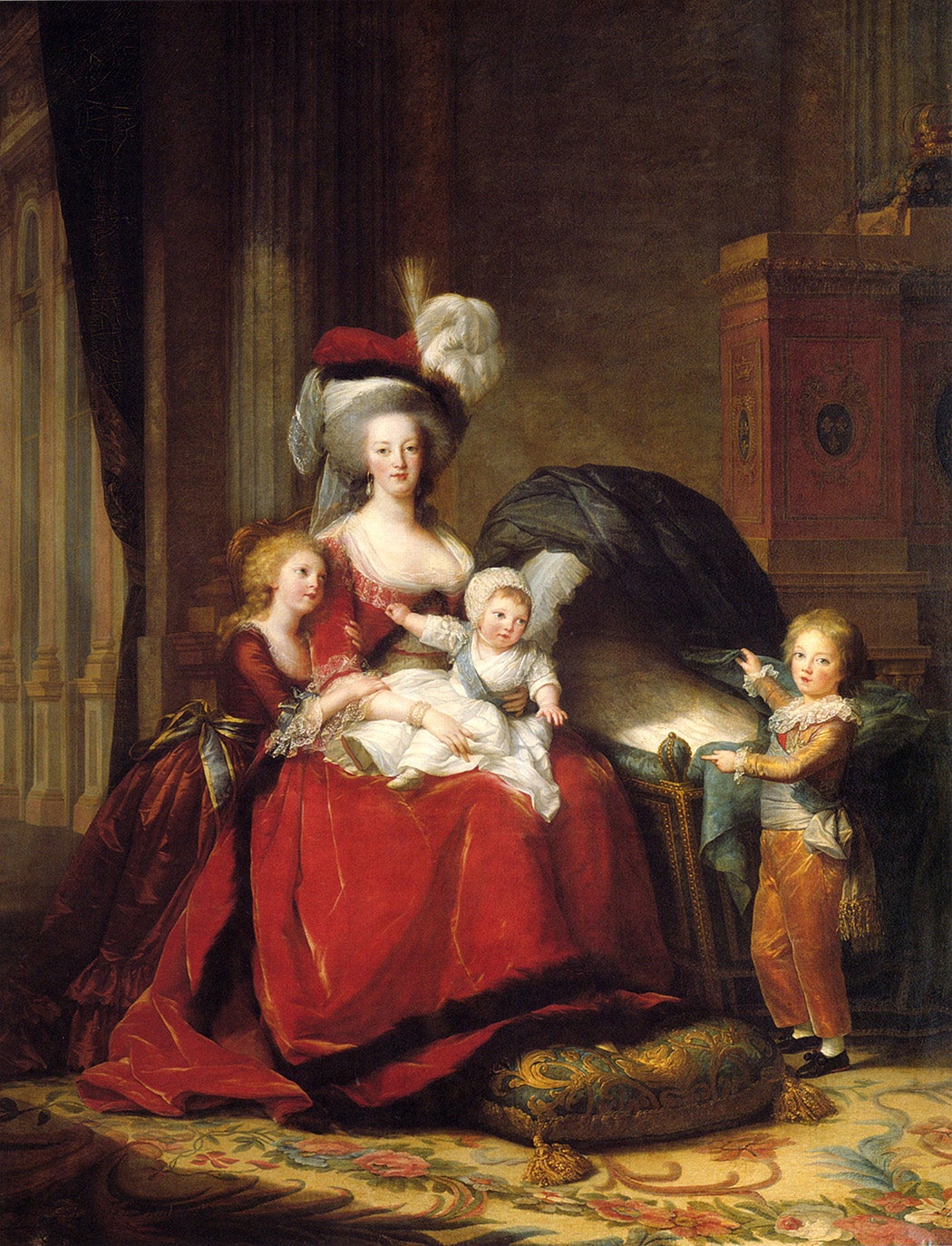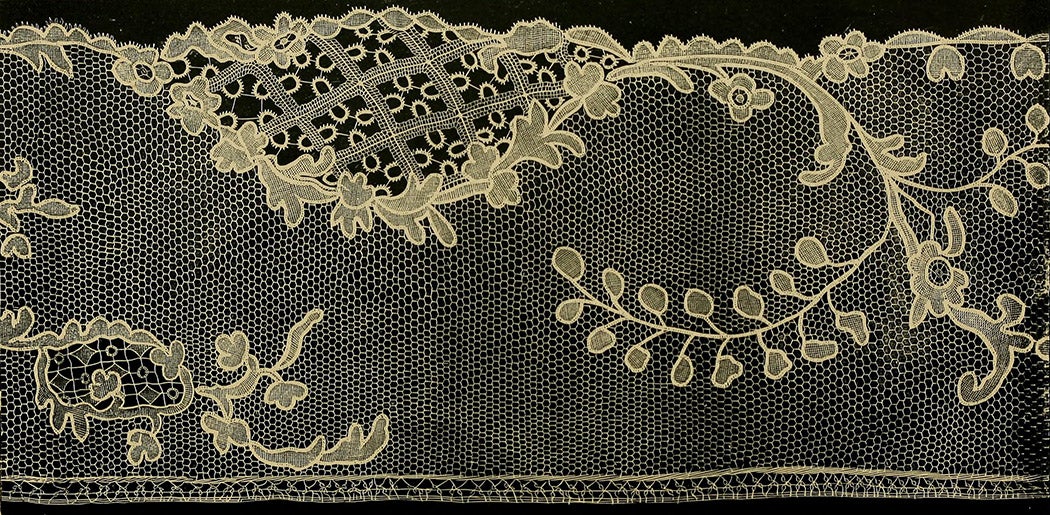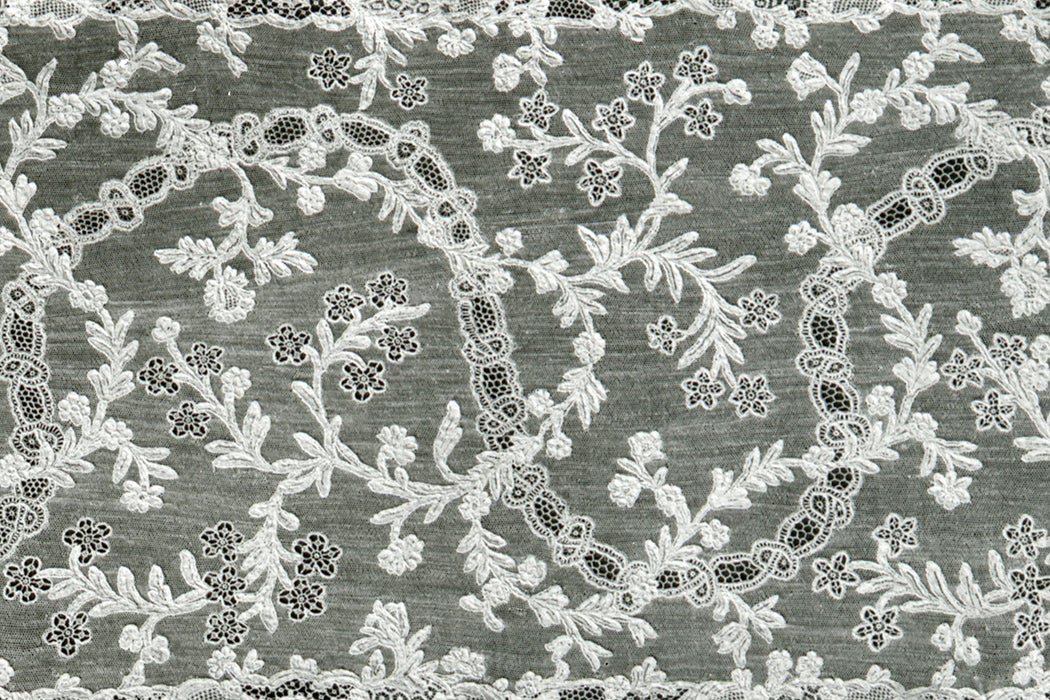“I still hang on to your Point d’Alençon lace. I show it to people and they all say it is pretty so I guess it is. The women rave over it so I am sure I got my $47.00 worth even if it is so small you can’t hardly find it.”
A U.S. doughboy stationed in France wrote these words to his beloved wife Vera in the waning days of World War I. He protected the little piece of lace through his deployment and brought it home to his wife, where it remained as a family heirloom for at least the next nine decades.
The $47 he names would have been a truly hair-raising sum at the time. The minuscule scrap of lace was a prize like a gemstone, but its basic materials are relatively cheap. The value is all in the artistry: a simple line of thread, knotted and looped into a snowflake complexity.
In an age of machine-made textiles, it is hard to recover how precious lace was in the days when each delicate stitch was picked out by hand. But there was a time when lace was as treasured as fine jewelry, and scraps of it would be carefully lifted from old articles of clothing and remounted on new ones.

Even in a world of handmade lace, Point d’Alençon is particularly time-consuming. Each square centimeter represents seven hours of work–not taking into account the years of apprenticeship required to develop the requisite skill. The demanding nature of the work and the luxurious quality of the final product earned Point d’Alençon the name “Queen of Lace.” Indeed, at that price, only royalty could afford to wear much of it. Consider this portrait of Marie Antionette, her sleeves and collar lined with Alençon lace. Each postage-stamp-sized square of those delicate flounces demanded a full day’s worth of expert labor.
Each piece of Point d’Alençon would pass through up to eighteen different hands before completion. First, a design is painted in white ink on black paper. Then its outline is carefully pricked out onto another sheet of paper. The skeleton of the lace is laid down in white threads, and the open spaces are filled in with a delicate mesh stitch. Little stars and wheels are formed to adorn the picture, and raised lines are executed around the patterns to give relief. It is like embroidering on empty space, an observation which gave an early form of Italian needle lace its name: punto in aria, stitch in air.

The lacemaker bends over the pattern, covering the lace with a piece of paper and working only through a tiny peephole snipped through the sheet. Once the pattern is complete, a razor blade slipped between the layers of cloth sets the lace free. The final step has a surrealist twist: the white threads are carefully polished with a lobster claw.
The early 1600s were marked by a growing obsession with lace amongst Europe’s nobility. This was the era of ornate lace collars. You’ve probably seen them in portraits of the era: the ornate, stiff collars that sit under the chins of the noble sitters, giving them a John the Baptist head-on-a-plate kind of look.
Anything that expensive tends to create drama. In its heyday, lace smuggling became the stuff of legend. Per the Smithsonian:
Stories are told about bodies being replaced by lace in coffins before being shipped across borders, dogs being wrapped in lace and covered with a larger hide; hollowed out loaves of bread filled with lace, and many other ingenious ways of getting laces to the rich and powerful.
This setting of international intrigue laid the groundwork for the invention of Alençon lace.

In the 1660s, the French government became increasingly concerned with the amount of money its nobles were spending on Venetian lace. The finance minister Jean-Baptiste Colbert hatched a plan to create a homegrown fine lace industry. He opened the state coffers to establish schools around the country and poached lacemakers from Venice to teach the local women.
The plan necessitated some serious crackdowns from the fashion police. French nobility were forbidden from wearing foreign lace, and only state-accredited dealers were permitted to buy French lace, to prevent the valuable designs from getting outside of the country and being copied. In 1670, a visitor to France wrote:
They are so set in this country upon maintaining their own manufactures that only two days ago there was publicly burnt by the hangman a hundred thousand crowns worth of Point de Venise, Flanders lace, and other foreign commodities that are forbid.
Yes, the hangman, as if the foreign laces were criminals condemned to death. But with time, the local lace schools developed their own sought-after styles, chief among them Point d’Alençon.
The relationship between monarchs and lacemakers was a complicated one. Only a small trickle of the vast sums expended on fine lace made its way back to the makers. But when the monarchy was abolished in the French Revolution, the market for luxury goods went with it. And considering all the hands that went into the making of a single piece of lace, that was quite a lot of women out of work.
Weekly Newsletter
Historian Dame Olwen H. Hufton suggests that this loss may have contributed to a growing disenchantment with the Revolution among the lower-class women of the lace-making towns:
Families which lost the input into the household economy of a working mother could expect, as we have seen, no substitute assistance. They had no claims upon whatever relief there was to be had. Need we be surprised that women were quick to associate the Revolution with increasing immiseration? Indeed, there may even have been an industry-specific response in which specialized work-forces, as at Lyons, became the earliest critics of the Revolution.
Appropriately enough, the Napoleonic Empire briefly brought Point d’Alençon back into the spotlight, along with the other gilded hallmarks of royal inequality. But it could not last long. The age of machine lace was approaching. By the mid-nineteenth century, nearly every type of hand-made lace could be successfully aped by machines. For a taste of techno-optimism of the period, consider this scrap of machine-made lace from 1900, adorned with trains, telegraph poles, and lightbulbs. It wears its mechanical origins proudly; even the traditional wheel motifs at the bottom seem to have mutated into cogs.







